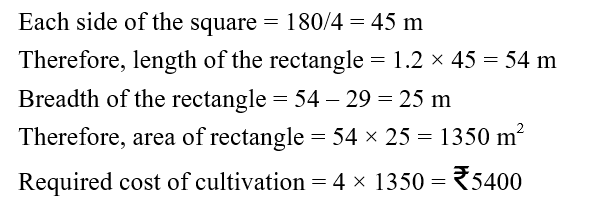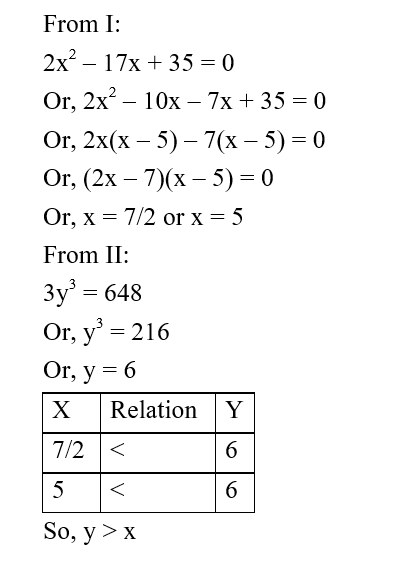Question 1:
Direction: What approximate value will come in place of the question mark (?) in the following question? (Note: You are not expected to calculate the exact value.)
निर्देश: निम्नलिखित प्रश्न में प्रश्न चिह्न (?) के स्थान पर क्या अनुमानित मान आएगा? (नोट: आपको सटीक मान की गणना करने की आवश्यकता नहीं है।)
(? × 19.89) + 479.80 = 24.78% of 3199.94
Question 2:
Direction: What approximate value will come in place of the question mark (?) in the following question? (Note: You are not expected to calculate the exact value.)
निर्देश: निम्नलिखित प्रश्न में प्रश्न चिह्न (?) के स्थान पर क्या अनुमानित मान आएगा? (नोट: आपको सटीक मान की गणना करने की आवश्यकता नहीं है।)
(94.92 + 445.17) ÷ (17.93 × 2.89) = ?
Question 3:
Direction: What approximate value will come in place of the question mark (?) in the following question? (Note: You are not expected to calculate the exact value.)
निर्देश: निम्नलिखित प्रश्न में प्रश्न चिह्न (?) के स्थान पर क्या अनुमानित मान आएगा? (नोट: आपको सटीक मान की गणना करने की आवश्यकता नहीं है।)
(7/16) × 3199.86 – 24.76% of 5600.45 = ? – 249.89
Question 4:
The perimeter of a square is 180 m. The length of a rectangular field is 20% more than the side of square and 29 m more than its own breadth. Find the cost of cultivating the rectangular field at the rate of ₹4/sq. metre.
एक वर्ग की परिधि 180 मीटर है। एक आयताकार मैदान की लंबाई वर्ग की भुजा से 20% अधिक और अपनी चौड़ाई से 29 मीटर अधिक है। रु. 4/वर्ग मीटर की दर से आयताकार मैदान को जोतने की लागत ज्ञात करें?
Question 5:
Direction: In the question, two equations I and II are given. You have to solve both the equations to establish the correct relation between x and y and choose the correct option.
निर्देश: प्रश्न में दो समीकरण I और II दिए गए हैं। आपको x और y के बीच सही संबंध स्थापित करने के लिए दोनों समीकरणों को हल करना है और सही विकल्प का चयन करना है।

Question 6:
Direction: In the question, two equations I and II are given. You have to solve both the equations to establish the correct relation between x and y and choose the correct option.
निर्देश: प्रश्न में दो समीकरण I और II दिए गए हैं। आपको x और y के बीच सही संबंध स्थापित करने के लिए दोनों समीकरणों को हल करना है और सही विकल्प का चयन करना है।

Question 7:
Directions: Answer the questions based on the information given below.
निर्देश: नीचे दी गई जानकारी के आधार पर प्रश्नों के उत्तर दें।
Number of paper mills in Agra is 20% more than that in Kota but 300 less than that in Jaipur. Number of paper mills in Patna is 300 more than that in Jaipur. Ratio of paper and textile mills in Patna is 5:2, respectively. Number of textile mills in Jaipur is 200 more than that in Patna and 80% of that in Agra. Number of textile mills in Kota is 25% less than that in Agra. Number of mills (paper + textile) in Kota is 1500.
आगरा में पेपर मीलों की संख्या कोटा की तुलना में 20% अधिक है लेकिन जयपुर की तुलना में 300 कम है। पटना में पेपर मीलों की संख्या जयपुर की तुलना में 300 अधिक है। पटना में पेपर और टेक्सटाइल मीलों का अनुपात क्रमशः 5:2 है। जयपुर में टेक्सटाइल मीलों की संख्या पटना की तुलना में 200 अधिक है और आगरा में टेक्सटाइल मीलों की संख्या का 80% है। कोटा में टेक्सटाइल मीलों की संख्या आगरा की तुलना में 25% कम है। कोटा में मीलों (पेपर + टेक्सटाइल) की संख्या 1500 है।
Find the ratio of number of paper mills in Jaipur to the number of textile mills in Agra.
जयपुर में पेपर मीलों की संख्या और आगरा में टेक्सटाइल मीलों की संख्या का अनुपात ज्ञात कीजिए।
Question 8:
Directions: Answer the questions based on the information given below.
निर्देश: नीचे दी गई जानकारी के आधार पर प्रश्नों के उत्तर दें।
Number of paper mills in Agra is 20% more than that in Kota but 300 less than that in Jaipur. Number of paper mills in Patna is 300 more than that in Jaipur. Ratio of paper and textile mills in Patna is 5:2, respectively. Number of textile mills in Jaipur is 200 more than that in Patna and 80% of that in Agra. Number of textile mills in Kota is 25% less than that in Agra. Number of mills (paper + textile) in Kota is 1500.
आगरा में पेपर मीलों की संख्या कोटा की तुलना में 20% अधिक है लेकिन जयपुर की तुलना में 300 कम है। पटना में पेपर मीलों की संख्या जयपुर की तुलना में 300 अधिक है। पटना में पेपर और टेक्सटाइल मीलों का अनुपात क्रमशः 5:2 है। जयपुर में टेक्सटाइल मीलों की संख्या पटना की तुलना में 200 अधिक है और आगरा में टेक्सटाइल मीलों की संख्या का 80% है। कोटा में टेक्सटाइल मीलों की संख्या आगरा की तुलना में 25% कम है। कोटा में मीलों (पेपर + टेक्सटाइल) की संख्या 1500 है।
40% of total mills (textile + paper) in Agra are privately owned. Find the number of privately owned mills in Agra.
आगरा में कुल मीलों (टेक्सटाइल + पेपर) का 40% निजी स्वामित्व में है। आगरा में निजी स्वामित्व वाली मीलों की संख्या ज्ञात कीजिए।
Question 9:
Directions: Answer the questions based on the information given below.
निर्देश: नीचे दी गई जानकारी के आधार पर प्रश्नों के उत्तर दें।
Number of paper mills in Agra is 20% more than that in Kota but 300 less than that in Jaipur. Number of paper mills in Patna is 300 more than that in Jaipur. Ratio of paper and textile mills in Patna is 5:2, respectively. Number of textile mills in Jaipur is 200 more than that in Patna and 80% of that in Agra. Number of textile mills in Kota is 25% less than that in Agra. Number of mills (paper + textile) in Kota is 1500.
आगरा में पेपर मीलों की संख्या कोटा की तुलना में 20% अधिक है लेकिन जयपुर की तुलना में 300 कम है। पटना में पेपर मीलों की संख्या जयपुर की तुलना में 300 अधिक है। पटना में पेपर और टेक्सटाइल मीलों का अनुपात क्रमशः 5:2 है। जयपुर में टेक्सटाइल मीलों की संख्या पटना की तुलना में 200 अधिक है और आगरा में टेक्सटाइल मीलों की संख्या का 80% है। कोटा में टेक्सटाइल मीलों की संख्या आगरा की तुलना में 25% कम है। कोटा में मीलों (पेपर + टेक्सटाइल) की संख्या 1500 है।
The number of paper mills in Kota is how much percent more/less than number of textile mills in Patna?
कोटा में पेपर मीलों की संख्या पटना में टेक्सटाइल मीलों की संख्या से कितने प्रतिशत अधिक/कम है?
Question 10:
Directions: Answer the questions based on the information given below.
निर्देश: नीचे दी गई जानकारी के आधार पर प्रश्नों के उत्तर दें।
Number of paper mills in Agra is 20% more than that in Kota but 300 less than that in Jaipur. Number of paper mills in Patna is 300 more than that in Jaipur. Ratio of paper and textile mills in Patna is 5:2, respectively. Number of textile mills in Jaipur is 200 more than that in Patna and 80% of that in Agra. Number of textile mills in Kota is 25% less than that in Agra. Number of mills (paper + textile) in Kota is 1500.
आगरा में पेपर मीलों की संख्या कोटा की तुलना में 20% अधिक है लेकिन जयपुर की तुलना में 300 कम है। पटना में पेपर मीलों की संख्या जयपुर की तुलना में 300 अधिक है। पटना में पेपर और टेक्सटाइल मीलों का अनुपात क्रमशः 5:2 है। जयपुर में टेक्सटाइल मीलों की संख्या पटना की तुलना में 200 अधिक है और आगरा में टेक्सटाइल मीलों की संख्या का 80% है। कोटा में टेक्सटाइल मीलों की संख्या आगरा की तुलना में 25% कम है। कोटा में मीलों (पेपर + टेक्सटाइल) की संख्या 1500 है।
Find the average number of textile mills in Kota, Agra and Jaipur.
कोटा, आगरा और जयपुर में टेक्सटाइल मीलों की औसत संख्या ज्ञात कीजिए।



